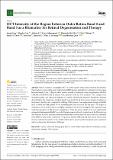| dc.contributor.author | Zeng, Yong | |
| dc.contributor.author | Gao, Shasha | |
| dc.contributor.author | Li, Yichao | |
| dc.contributor.author | Marangoni, Dario | |
| dc.contributor.author | De Silva, Tharindu | |
| dc.contributor.author | Wong, Wai T. | |
| dc.contributor.author | Chew, Emily Y. | |
| dc.contributor.author | Sun, Xun | |
| dc.contributor.author | Li, Tiansen | |
| dc.contributor.author | Sieving, Paul A. | |
| dc.contributor.author | Qian, Haohua | |
| dc.date.accessioned | 2024-05-24T19:16:00Z | |
| dc.date.available | 2024-05-24T19:16:00Z | |
| dc.date.issued | 2024-05-01 | |
| dc.identifier.issn | 2306-5354 | |
| dc.identifier.uri | https://hdl.handle.net/1721.1/155072 | |
| dc.description.abstract | Optical coherence tomography (OCT) is widely used to probe retinal structure and function. This study investigated the outer retina band (ORB) pattern and reflective intensity for the region between bands 2 and 3 (Dip) in three mouse models of inherited retinal degeneration (Rs1KO, TTLL5KO, RPE65KO) and in human AMD patients from the A2A database. OCT images were manually graded, and reflectivity signals were used to calculate the Dip ratio. Qualitative analyses demonstrated the progressive merging band 2 and band 3 in all three mouse models, leading to a reduction in the Dip ratio compared to wildtype (WT) controls. Gene replacement therapy in Rs1KO mice reverted the ORB pattern to one resembling WT and increased the Dip ratio. The degree of anatomical rescue in these mice was highly correlated with level of transgenic RS1 expression and with the restoration of ERG b-wave amplitudes. While the inner retinal cavity was significantly enlarged in dark-adapted Rs1KO mice, the Dip ratio was not altered. A reduction of the Dip ratio was also detected in AMD patients compared with healthy controls and was also positively correlated with AMD severity on the AMD score. We propose that the ORB and Dip ratio can be used as non-invasive early biomarkers for retina health, which can be used to probe therapeutic gene expression and to evaluate the effectiveness of therapy. | en_US |
| dc.publisher | MDPI AG | en_US |
| dc.relation.isversionof | 10.3390/bioengineering11050449 | en_US |
| dc.rights | Creative Commons Attribution | en_US |
| dc.rights.uri | https://creativecommons.org/licenses/by/4.0/ | en_US |
| dc.source | Multidisciplinary Digital Publishing Institute | en_US |
| dc.title | OCT Intensity of the Region between Outer Retina Band 2 and Band 3 as a Biomarker for Retinal Degeneration and Therapy | en_US |
| dc.type | Article | en_US |
| dc.identifier.citation | Zeng, Y.; Gao, S.; Li, Y.; Marangoni, D.; De Silva, T.; Wong, W.T.; Chew, E.Y.; Sun, X.; Li, T.; Sieving, P.A.; et al. OCT Intensity of the Region between Outer Retina Band 2 and Band 3 as a Biomarker for Retinal Degeneration and Therapy. Bioengineering 2024, 11, 449. | en_US |
| dc.relation.journal | Bioengineering | en_US |
| dc.identifier.mitlicense | PUBLISHER_CC | |
| dc.eprint.version | Final published version | en_US |
| dc.type.uri | http://purl.org/eprint/type/JournalArticle | en_US |
| eprint.status | http://purl.org/eprint/status/PeerReviewed | en_US |
| dc.date.updated | 2024-05-24T13:04:52Z | |
| dspace.date.submission | 2024-05-24T13:04:51Z | |
| mit.journal.volume | 11 | en_US |
| mit.journal.issue | 5 | en_US |
| mit.license | PUBLISHER_CC | |
| mit.metadata.status | Authority Work and Publication Information Needed | en_US |
